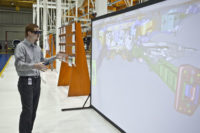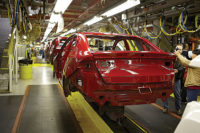“This is a crucial vehicle launch for the company as we re-enter the compact sedan market,” says Doug Betts, senior vice president of quality “We’ve invested $20 million in our Belvidere Assembly Plant to make quality improvements and ensure consistent build quality of the Dodge Dart.
“We obsessed over the quality and refinement of the Dart as it was developed, tested and built,” adds Betts. “As a company, we’ve really overhauled our processes and expectations for building quality vehicles and doing whatever it takes to satisfy customers.”
Betts claims that Chrysler has been improving its overall quality by an average of 15 percent annually. That’s a much higher rate than the entire auto industry, which averages around 3 percent. “We’ve achieved a 59 percent reduction in warranty claims since 2007,” he points out.
According to Betts, performance quality measures how well a vehicle matches customer priorities and stacks up against its competition. Criteria such as acceleration, braking, handling, seat comfort, quietness, storage space and fuel economy are among the hundreds of attributes that engineers compare vs. competitive cars.
“Knowing that many car buyers make judgments about a vehicle’s quality the first time they see it, our perceived quality (PQ) team set the bar high so that the Dart would fare well under the scrutiny of the most discerning car shoppers,” explains Betts.
“The PQ team works with designers, engineers and suppliers to enhance the fit-and-finish, surface quality, material options, and even the sound quality of moveable parts like doors and storage bins,” says Betts. “The Dart is the first Chrysler Group vehicle program that used PQ best practices from the start of development.
“Although the Dart will compete in the heart of the compact sedan segment, the PQ team benchmarked more expensive European sedans [so that the vehicle] will look and feel comparable to an entry luxury sedan under close inspection,” Betts points out.
To ensure reliability, the Dart has racked up 8.5 million miles of testing on public roads. A fleet of more than 100 vehicles has been driven day and night in five different regions of the United States. In addition, 60 to 100 Darts are randomly pulled off the Belvidere assembly line and driven in town and on the highway for up to 50 miles.
Fiat has invested heavily in new technology and processes to improve the quality of Chrysler’s vehicles. For instance, a $12.5 million metrology center at the Belvidere plant houses state-of-the-art dimensional control equipment, such as coordinate measuring machines, laser trackers and portable scanners, that allow manufacturing engineers to find sources of build variation and resolve any fit-and-finish issues. So far, more than 400 issues have been identified and fixed.
Suppliers were required to send in sample parts two weeks prior to each build phase of the new Dart. “The metrology center can measure parts and work with suppliers to find and fix any issue before production of customer vehicles,” says Betts. “Previously, fit issues might not have been discovered until after a vehicle was assembled.
“Similarly, if new issues are discovered on the assembly line, the metrology center can reactively apply its state-of-the-art measurement tools to find the root cause of issues—whether it’s an issue with the vehicle body, a part or tooling,” Betts points out.
Engineers have installed quality gates on the plant floor to check for 16 potential operator errors on the door line and the trim line. If a problem is discovered, the assembler who made the error is asked to check it out and then figure out what happened.
“If someone learns something four times, they’ll retain 90 percent of the knowledge,” says Chris Kelly, quality control manager at the Belvidere plant. “That’s more effective than being told what to do by a supervisor or a team leader.”
Fiat also invested $3 million in a new Center for Technical Vehicle Validation (CTVV) and Materials Laboratory— the first such quality center in a Chrysler Group plant in the United States. The 16,344-square-foot facility is staffed by a team of engineers who use 465 pieces of test equipment and tools.
The CTVV randomly audits newly built Dodge Darts and measures 437 functional characteristics, including emissions, fit-and-finish, heating and air conditioning performance, and ride height. Within the gap-flush inspection bay, an operator measures 238 interior fit characteristics and 121 exterior fit characteristics.
“Approximately half of the measurements are tied to perceived quality goals and the other half validate the functional targets for a car,” says Betts. “The CTVV and materials laboratory allow the Belvidere plant to identify and troubleshoot emerging issues onsite, with fewer delays from sending parts to [Chrysler headquarter in] Auburn Hills, MI, or supplier locations for analysis.”







